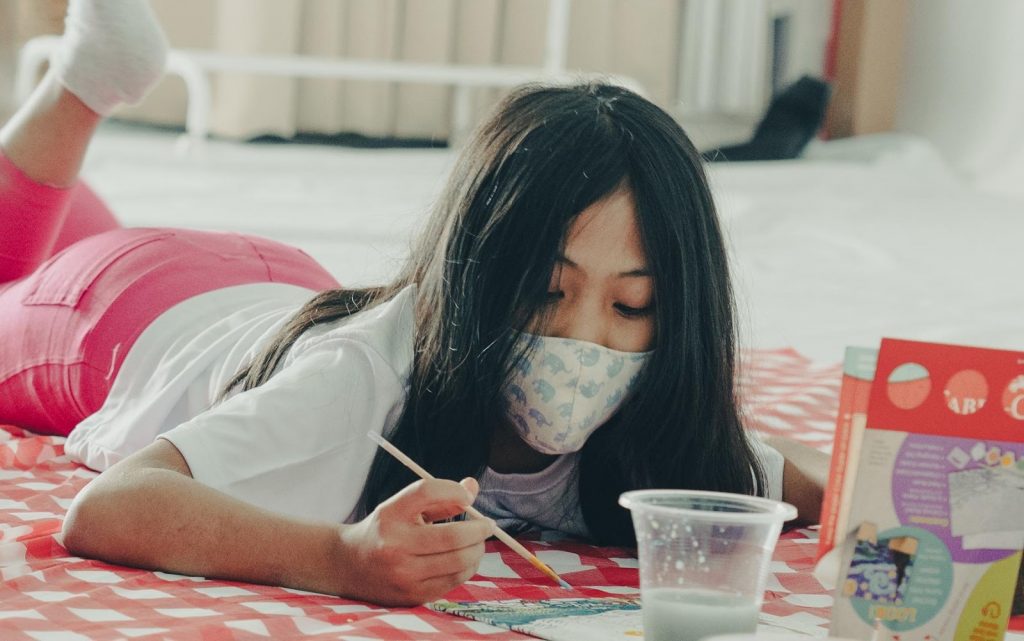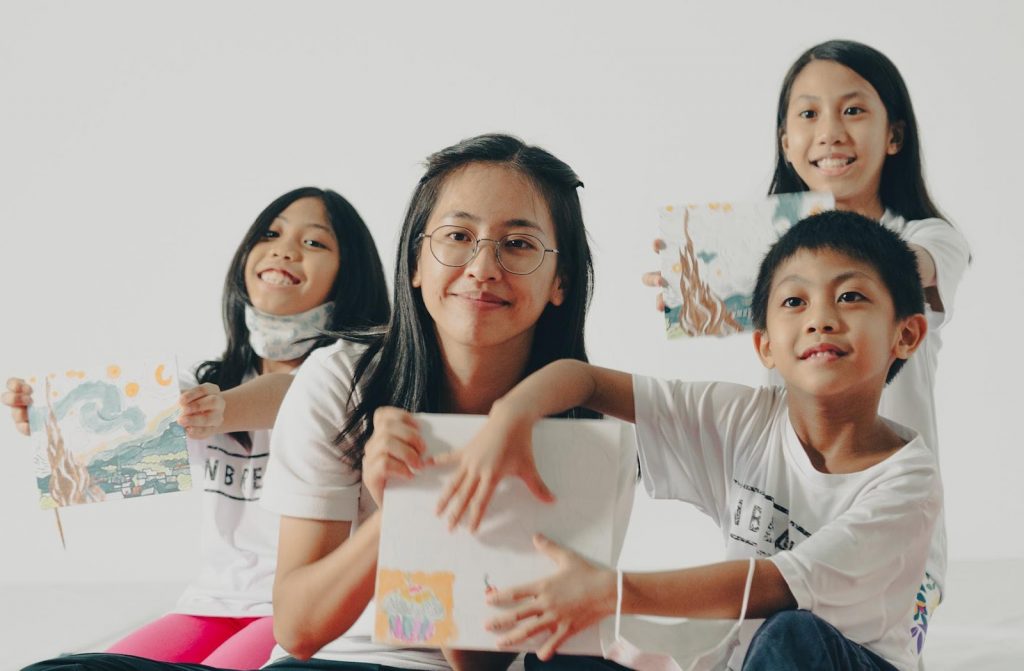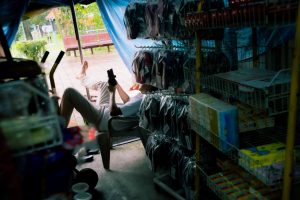Top Image: Jeremy Lau for RICE Media
As Mariah Carey fills the air and the average salaryman mentally tabulates what their year-end bonus would be, something else makes its annual appearance: Charity volunteers ringing bells asking for donations to their causes.
If the throngs of people dropping change into the buckets are anything to go by, there’s definitely something about the season of giving that inspires generosity and empathy in us. But is there anything else we can give apart from cold, hard cash?
Sheepish as we are to admit, most of us haven’t walked the ground to connect with charities since our secondary school days. We’re out of touch with what charities need, and so seemingly basic things like preloved clothes, canned food and children’s toys become our default go-to donations.
But as Christmas comes and goes, our well-meaning gifts may very well end up in the discard pile.
One Man’s Trash is Another Man’s… Trash, Still

Jo Anne and Weili politely smile, as much as is visible behind their masks at least, when I ask them about the donations Glyph received in 2020. The pair are full-timers at the charitable organisation for children from disadvantaged backgrounds.
Glyph received boxes upon boxes of gifts from donors — all of them individually wrapped, some with heartfelt messages written on them in hopes of bringing a little extra cheer to their prospective recipients.
What laid within, however, were stacks of preloved items that left the pair and the rest of their Glyph colleagues crestfallen. I’m sure the donors meant well when they donated their preloved items, and I say as much to Jo Anne.
The issue, she clarifies, is how each person perceives the term ‘preloved’.
Rather than ‘preloved’, some of the donations they received could better be termed as ‘well-used’: Books torn beyond repair, shoes and clothing so yellow they looked as though they were dyed that shade, and tons of soft toys (which can’t be donated, because of hygiene).
Glyph understands donors genuinely want to help. Many of their donations were once loved by their own children, had once brought joy and smiles to their faces, and hoped it would find a new lease on life doing the same for other children in need.

Image: Rainer Cheung for RICE Media
Unfortunately, from the pile of donations they received, Glyph’s Deputy Head (Corporate Sponsorships) Si Hui reckons only 50 per cent of them could be repurposed for the organisation and their beneficiaries. Misplaced donations had to be repackaged and sent to other charities and organisations, while the remaining… non-recyclables… were trashed.
“Just sorting out the donations alone took about three to five hours,” she revealed.
Apart from the obvious waste of time and manpower that could’ve been better spent helping beneficiaries, misplaced donations also mean other charities that do actually need them don’t get it.
To put it plainly: The wrong donations achieve nothing. Except maybe making the oblivious donors feel good about themselves.
All I Want For Christmas Is…
“What would you like for Christmas this year?” Si Hui asks.
“For two friends to come and celebrate with me!” six-year-old John exclaims, nearly knocking over his half-painted canvas in the process.
Two friends, he says, because the previous round of social restrictions limited household guests to two a day. He hasn’t realised he can invite his third best friend along now that the restrictions have been relaxed.
His sister Felicia, 8, on the other hand, wants a unicorn.
At Si Hui’s raised eyebrow, Nareene, the two’s 10-year-old big sister, chirps: the younger actually has four.

Image: Isaiah Chua for RICE Media
Watching them fiddle around with their paintings talking about their wants and want-nots, they’re no different from the kids I see running around town every other day. That, perhaps, is the most confusing thing for donors to grasp.
Thanks to community involvement programmes and mission trips during our secondary school days, there’s this implicit expectation that underprivileged children are those without food, clothing or shelter over their heads. When donors see the kids at Glyph holding supposedly expensive gadgets, they might question if the children actually need assistance.
Absolute poverty, Si Hui tells me, is what donors often conflate the term underprivileged with.
While absolute poverty does exist in Singapore, more often than not, the underprivileged in Singapore fall into the category of relative poverty — those who aren’t well to do but aren’t “poor enough” to get financial assistance.
Without access to resources, children from lower-income families are in situations where they cannot afford to actively participate in society and benefit from experiences that most people take for granted.
In our kiasu culture, that means activities like tuition, enrichment classes, field trips and sports. Material goods they get are just means in which their parents hope to make them feel socially included, even if it comes at a price.

Rainer Cheung for RICE Media
Compared to clothes, soft toys or even non-perishable food items, what the kids actually need is a safe environment for them to learn and socialise outside of school while their parents hustle, and that’s what Glyph provides through their various enrichment programmes.
Si Hui asks the trio if they’d like more paints for Christmas. There’s a resounding cheer in response. Paint, brushes, colour pencils, tablets, microphones: it’s materials like these that Glyph uses to facilitate the holistic education programmes that they constantly find themselves running short on. Beyond those, seemingly menial items such as printing paper and batteries make up the bulk of the charity’s to-buy list.
“These are items we require for the day-to-day running of the programmes and administrations, but most donors don’t know that.”
Glyph’s team is small — pretty much all their time is spent organising and running non-academic activities for the children, holding outreach efforts and growing the organisation. It’s easy to see how the right donation, no matter how small, can ease their burdens and help their mission.
Making a List and Checking it Twice
No one’s born a mindreader — you can’t possibly know what someone wants if they don’t tell you. Even Santa needs kids to write him a list of what they want.
While some beneficiaries have public wishlists out there, they’re few and far between. Not to mention you’ve got to source what they want yourself and bring it to them.
In a bid to meet donors halfway (and to play Santa’s elves), Amazon introduced its Shop for Good wishlist initiative to support non-profit organisations by having participating charities upload a list of items they require on their website — all of which are tied to the relevant listing from sellers on Amazon.
Donors can (essentially) hit check out on their behalf and the donations are then delivered directly to their doorsteps. The flexibility of the wishlist also means donors can opt to donate as and when they want to, in whatever quantity or budget they’re comfortable with.
To prevent a repeat of last year’s events, Glyph uploaded their own wish list via Amazon this year, detailing what they need, how much they need, and how urgently they need the items. As social restrictions ease up, they’re looking to hold more activities in person again, which means they’ve got to stock up on all their art and teaching materials.
And in a room full of rambunctious kids, the staff realised they’d need microphones in order to be heard.

Image: Rainer Cheung for RICE Media
If donors know exactly what the charity needs, they’d be able to support them more effectively. The convenience of it is undeniable, Si Hui notes. “There are actually quite a few people who want to volunteer with us but our schedules don’t quite match up. So for them, this is how they contribute without having to be here in person.”
In a similar vein, Amazon’s wishlist also allows non-profit organisations to be more transparent with their donors. Glyph often gets prospective donors asking how financial donations are used during their outreach events; When it comes to transparency, the wishlist lays out exactly how their money gets used, Jo Anne adds.
“We’re a young charitable organisation that’s only been around for four years. Unlike larger, more well-known charities, we have to be doubly transparent to make donors believe in us and our cause. With this wishlist, donors can control exactly where their money goes.”
In addition, Amazon is matching the donations Glyph receives through the wishlist during the month of December. Whatever donors gift, Amazon will match in cash value to double the aid Glyph receives, up to S$10,000.
Small Gifts, Big Hearts
With Christmas coming up soon, Glyph’s staff hopes they can make the year-end extra special for their children. As it is, they’ve been ramping up efforts to connect with more people on the streets, hoping to get more people to contribute to their cause.
While I watch from the sidelines, I see them getting waved off by uninterested members of the public more often than they’re able to have someone stop and chat. Even then, they keep going without a falter in their step, their selflessness driven solely by a wholehearted dedication to doing whatever they can to level the playing field for children and equalise opportunities.
I don’t remember when was the last time I donated to a cause, but I remember the last few excuses I’ve given. The beneficiaries are too far away; no one would want my old clothes; I’m too lazy to pack. Long story short, I’ve furnished more excuses than actually doing anything to help.
As I’ve learnt, it doesn’t take much to make a difference for children’s charities like Glyph, where often the most menial things matter the most. This season of giving, maybe it’s time to put aside whatever image of a philanthropist Tony Stark conjures and realise the barriers to being a Samaritan aren’t that high after all.







